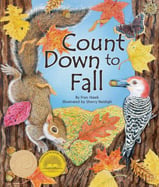Alignment to Standards for NY

| Grade | Number | Standard |
|---|---|---|
| K,1,2,3,4 | K-4..3.1a (iv) | claws, shells, spines, feathers, fur, scales, and color of body covering enable some animals to protect themselves from predators and other environmental conditions, or enable them to obtain food |
| K,1,2,3,4 | K-4.1.1a(iii) | Natural cycles and patterns include the length of daylight and darkness varying with the seasons |
| K,1,2,3,4 | K-4.1.1a(iv) | Natural cycles and patterns include weather changing from day to day and through the seasons |
| K,1,2,3,4 | K-4.1.1b | Plants require air, water, nutrients, and light in order to live and thrive. |
| K,1,2,3,4 | K-4.3.1a (i) | wings, legs, or fins enable some animals to seek shelter and escape predators |
| K,1,2,3,4 | K-4.3.1a (iii) | eyes, nose, ears, tongue, and skin of some animals enable the animals to sense their surroundings |
| K,1,2,3,4 | K-4.3.1a (vi) | the characteristics of some animals change as seasonal conditions change (e.g., fur grows and is shed to help regulate body heat; body fat is a form of stored energy and it changes as the seasons change) |
| K,1,2,3,4 | K-4.3.1b | Matter has properties (color, hardness, odor, sound, taste, etc.) that can be observed through the senses |
| K,1,2,3,4 | K-4.3.1b | Each plant has different structures that serve different functions in growth, survival, and reproduction. |
| K,1,2,3,4 | K-4.3.1b (i) | roots help support the plant and take in water and nutrients |
| K,1,2,3,4 | K-4.3.1b (ii) | leaves help plants utilize sunlight to make food for the plant |
| K,1,2,3,4 | K-4.3.1b (iii) | stems, stalks, trunks, and other similar structures provide support for the plant |
| K,1,2,3,4 | K-4.3.1b (vi) | seeds contain stored food that aids in germination and the growth of young plants |
| K,1,2,3,4 | K-4.3.1c | Objects have properties that can be observed, described, and/or measured: length, width, volume, size, shape, mass or weight, temperature, texture, flexibility, reflectiveness of light |
| K,1,2,3,4 | K-4.3.1c | In order to survive in their environment, plants and animals must be adapted to that environment. |
| K,1,2,3,4 | K-4.3.1c (i) | seeds disperse by a plantês own mechanism and/or in a variety of ways that can include wind, water, and animals |
| K,1,2,3,4 | K-4.3.1c (iii) | animal adaptations include coloration for warning or attraction, camouflage, defense mechanisms, movement, hibernation, and migration |
| K,1,2,3,4 | K-4.3.1f | Objects and/or materials can be sorted or classified according to their properties. |
| K,1,2,3,4 | K-4.4.1b | Each kind of plant goes through its own stages of growth and development that may include seed, young plant, and mature plant. |
| K,1,2,3,4 | K-4.4.2b | Food supplies the energy and materials necessary for growth and repair. |
| K,1,2,3,4 | K-4.5.1b | An organismês external physical features can enable it to carry out life functions in its particular environment. |
| K,1,2,3,4 | K-4.5.2a | Plants respond to changes in their environment. the leaves of some green plants change position as the direction of light changes; the parts of some plants, undergo seasonal changes that enable the plant to grow; seeds germinate, and leaves, |
| K,1,2,3,4 | K-4.5.2b | Animals respond to change in their environment, (e.g., perspiration, heart rate, breathing rate, eye blinking, shivering, and salivating). |
| K,1,2,3,4 | K-4.5.2f | Some animal behaviors are influenced by environmental conditions:nest building, hibernating, hunting, migrating, and communicating. |
| K,1,2,3,4 | K-4.6.1a | Green plants are producers because they provide the basic food supply for themselves and animals. |
| K,1,2,3,4 | K-4.6.1e | An organismês pattern of behavior is related to the nature of that organismês environment, including the kinds and numbers of other organisms present, the availability of food and other resources, and the physical characteristics of the environment. |
| K,1,2,3,4 | K-4.6.2a | Plants manufacture food by utilizing air, water, and energy from the Sun. |
| K,1,2,3,4 | K-4.6.2b | The Sunês energy is transferred on Earth from plants to animals through the food chain. |